Welcome to the first 2022 installment of Atlantic Transport News!
Here’s a look at what you’ll find in this edition:
- Holiday travellers face COVID challenges
- VIA takes first step in “Non-Corridor” Fleet Renewal
- Two New Brunswick VIA stations are no more
- Patience wears thin over delayed Chignecto report
- Halifax Transit launching new initiatives in 2022
- Labrador’s first ever transit system proposed
HOLIDAY TRAVELLERS FACE COVID CHALLENGES
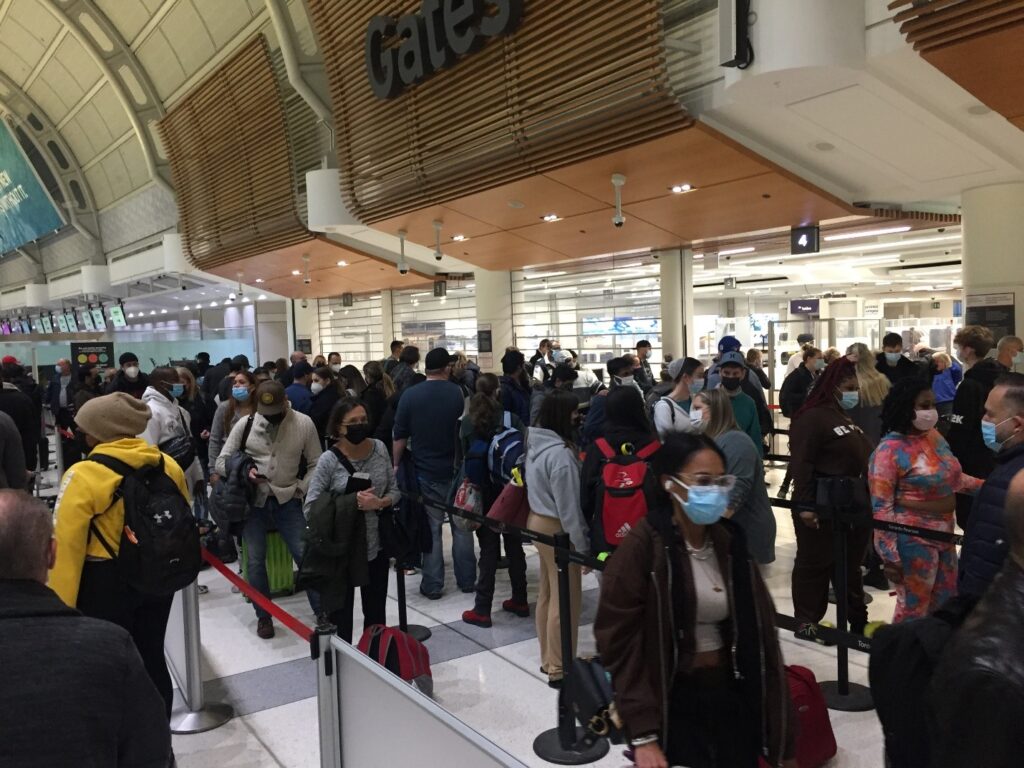
While many Atlantic Canadians chose the cautious route over the Christmas-New Year period by staying close to home for the festive season, there was still a scaled-down version of the annual holiday travel rush.
The resurgent tide of COVID infections in the region, across Canada, and world-wide, clearly impacted the travel industry’s gradual recovery that had been evident through the fall months. But despite a lot of cancellations by concerned potential passengers, holiday travel was much busier than in 2020. Your co-editors were among those who did venture outside the region in December – one by rail and the other by air – and their anecdotal observations are included in this story.
VIA Rail’s service offering in the Maritimes was a far cry from the extra trains and lengthy consists of fairly recent years, but relative to the once a week frequency that had been in place from the service restart in August, having two departures a week made it at least a bit easier to plan Christmas travel. Bookings had been strong in the lead-up, and there was much rumbling about extra equipment being added for both trainsets; however, by the time the holiday season was approaching, new concerns about the rapidly spreading omicron variant undoubtedly swayed some travellers to take advantage of VIA’s flexible cancellation and refund policy and cancel or postpone their travel. Trains over the holidays were still busy and expanded up to 17 cars, but did not seem to be quite as heavily patronized as initially expected.
Travel on the Ocean ahead of Christmas was not that much different from in the past, aside from the new consist and lack of a Park car. Proof of vaccination was checked in the station while checking in, with a sticker provided so passengers wouldn’t be bothered again during their journey. For sleeper passengers, all the usual accommodations in both Renaissance and HEP sleepers (aside from open sections) were available, and the full hot menu had returned to the dining car, also available by room service for those not comfortable dining in the shared space. All meals were up the usual standard, and the quality was consistent both in the dining car and by room service. Masks were required when moving through the train, as well as at all times for passengers in Economy, and compliance appeared to be strong across the board. The service car lounges were open and available, though canteen service was by cart only for those in the coaches. On time performance of this particular westbound trip was good across the board, with an arrival in Montreal just a few minutes behind schedule – lots of time to make connections on toward either Ottawa or Toronto.
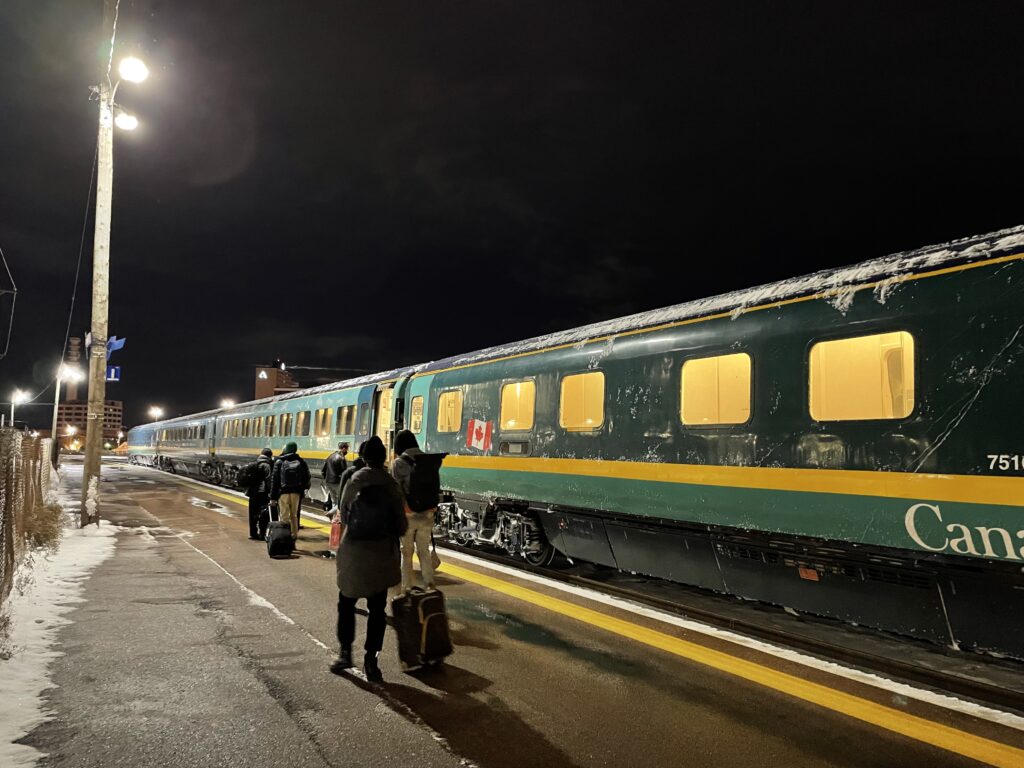
By the return trip after Christmas, the service had once again tightened up in recognition of the rapidly evolving COVID situation. The dining car remained on offer, though room service seemed to be more heavily patronized. The service cars were closed, and passengers were asked to remain at their seats or rooms as much as possible for the duration of the trip. Compliance with these rules again appeared to be quite consistent across the board, even in the coaches.
On this particular trip, on-time performance was hampered from the beginning by a very late arriving connecting train from Toronto – VIA held the Ocean to ensure passengers wouldn’t be stuck in Montreal for several days! Though some time was initially recovered, more was lost due to a series of ongoing slow orders on the Newcastle Sub, and even more by a forced detour through Rockingham yard on the final approach to Halifax. Far too often of late, CN has been leaving cars parked on the mainline and forcing the Ocean to make a painfully slow detour around through the yard tracks. Such treatment from their host railway is certainly nothing new, but it continues to be a major thorn in the side of VIA’s operations.
The outbound leg of a round trip by WestJet from Moncton to Toronto was a rather uneventful experience, apart from the usual pandemic precautions of continuous masking and hand sanitizing, but the return flight from Canada’s busiest airport was another story. In sharp contrast to the smooth check-in and uncrowded security at Moncton on December 16, Pearson’s Terminal 3 was quite a chaotic scene on the morning of December 30. There were technical issues at the bag drop, and a long queue at security where social distancing appeared to be a totally foreign concept. Furthermore, many travellers weren’t wearing their masks properly or were using improvised versions, and staff seemed to be actively discouraging anyone who attempted to avoid crowding their fellow passengers.
The Moncton departure was consistent with earlier anecdotal experiences at Halifax and St. John’s airports in November – a general atmosphere that gave travellers some sense of assurance that those in charge were taking their public health responsibilities seriously. And this before the Omicron variant had reared its ugly head. Not so at Pearson, where one couldn’t help but feel somewhat ill at ease amid rapidly escalating case counts.
“Overall, our industry like many others is not immune to the quick spread of Omicron, which at times is affecting service delivery among some businesses and airport partners,” says Tiffany Chase, spokesperson for Halifax Stanfield. “We’re asking for anyone travelling to be patient if they experience longer than usual line ups and to arrive with plenty of time to make their way through the various health and security screening processes prior to their flight. Travellers are also reminded of the public health protocols in place at the airport, including mandatory vaccination for those 12 years and older, always wearing a mask, frequent hand washing and sanitizing, enhanced cleaning of high touch surfaces, and reduced seating available at airport eating establishments.”
On December 30, WestJet announced the cancellation of 15% of its flights, and said it would rebook affected passengers on alternative departures. The airline blamed the Omicron variant for the drastic move, and claims that it could not have anticipated the variant’s “rapid and unpredictable impact” on its operations. Air passenger rights advocate Gabor Lukacs of Halifax isn’t buying that explanation, and suspects that the company is attempting to evade its obligations under the already-loose federal regulations regarding cancelled flights. The group’s website suggests that WestJet is trying to save money – a lot of money – by claiming the cancellations are due to circumstances beyond its control, and it therefore doesn’t have to compensate affected passengers for meal and accommodation expenses.
Meanwhile, Maritime Bus carried 7800 passengers throughout Nova Scotia, New Brunswick and Prince Edward Island in December – a significant improvement over the previous year but still down 55% from the number of fares recorded in the same month of 2019, before the pandemic struck. But reduced holiday travel meant that more people were sending Christmas packages by bus. The company handled 10,000 shipments last month, helping offset the lost revenue from fewer paying passenger.

Some travellers who sought to minimize their COVID exposure by driving home for the holidays in their own cars and taking advantage of Marine Atlantic’s generous social distancing capabilities found their plans frustrated by high winds and heavy seas in the Cabot Strait. With incredibly cruel timing, adverse weather closed in on December 23, forcing cancellation of all sailings on Christmas Eve.
-Tim Hayman/Ted Bartlett
VIA TAKES FIRST STEP IN “NON-CORRIDOR” FLEET RENEWAL
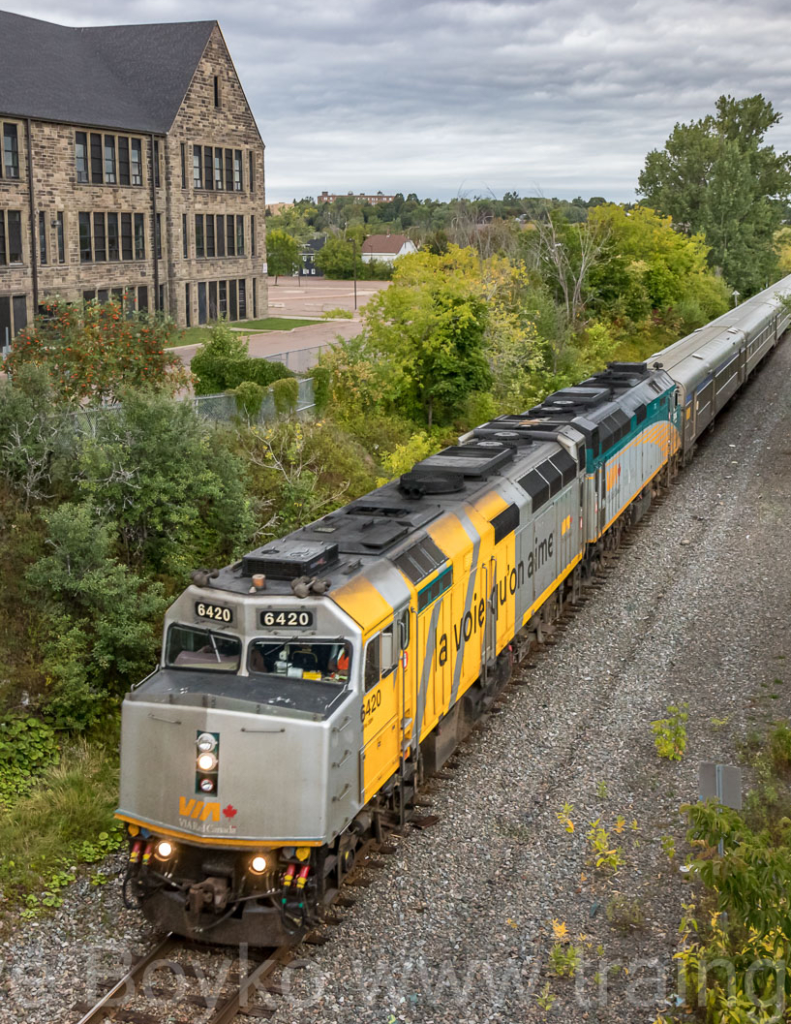
A tentative first step toward the badly needed replacement of VIA Rail Canada’s tired long-haul fleet appears to be in the offing. The timing may be just coincidence – it probably wasn’t really intended as a Santa surprise for Canadians who’ve been waiting many years for action by the Crown corporation and its political masters on this issue. But on the morning of Christmas Eve, without fanfare of any kind, a notice quietly appeared at VIA’s behest on MERX, a tender publishing website that bills itself as “Canada’s #1 Source of Business Opportunities”.
Entitled “Non-Corridor Fleets Renewal Market Day”, the solicitation was notably short on detail, but was nonetheless a hopeful signal that something may finally be happening to address an issue that’s been neglected for decades. The solicitation was identified as an informal request for information, and the bid intent was shown as “not available”. Only two sentences were offered as a project description, which reads as follows:
“VIA Rail is pleased to invite all tier 1 original equipment manufacturers of intercity and long-distance rail cars and locomotives to attend the virtual VIA Rail non-corridor fleets renewal market day. The day will be dedicated to both informing the market about the fleet renewal opportunity and addressing the context of the Government of Canada’s 2022-2023 Budget.”
VIA has so far not been forthcoming with any additional information, and there has been no media release on the subject. However, the cryptic MERX posting does suggest that there may be some funding in the upcoming federal budget to at least begin the process. Transport Action Atlantic views this as an encouraging sign, and has asked the corporation’s management for clarification and details on the current status.
It’s no secret that the equipment currently in use on VIA’s long-haul trains – now just a shadow of the once-substantial network that existed at the corporation’s inception in 1978 – is well past its best-before date. The classic stainless steel cars built for Canadian Pacific by the Budd Company of Philadelphia in 1954-55 are now in the twilight of their long careers, although some of them have recently undergone significant refurbishment. However, a plan to adapt some of the vintage coaches to accommodate passengers with special mobility needs had to be abandoned when it was discovered that the cars weren’t structurally compatible with the intended retrofit. The more recent British-built Renaissance cars that entered VIA service in the Maritimes more than two decades ago were problematic from the get-go, as they were never designed or intended for the challenges of life in Canada. They have also proven to be far less durable than the much older US-built cars, and are in fact more urgently in need of replacement. The F40 diesel locomotives that haul all of VIA’s long-distance trains are more than 35 years old, and although almost all of them have been rebuilt to extend their service life and reduce exhaust emissions, the clock is ticking for them as well.
Needless to say, TAA will be watching this development with keen interest. Stay tuned!
-Ted Bartlett
TWO NEW BRUNSWICK VIA STATIONS ARE NO MORE

Featured on the rear cover of our most recent Spring-Summer 2021 Bulletin, we had received news that two small stations in New Brunswick, those at Jacquet River and Charlo, were soon to be demolished due to deteriorating condition of the structures and the prohibitive cost of rehabilitation. Though we don’t currently have details of exactly when the structures were removed, we were able to confirm over the holidays that both stations have been torn down. All that remains at each site is the parking lot, platform, a small sign-board, and other associated VIA signage at the roadside.
The stops do continue to be served, and there appear to be no plans to stop serving either stop – Springhill Jct. remains an example of how a stop can stay on the schedule, without having anything more than a patch of gravel by the tracks! It remains to be seen whether either community will step up to build any form of structure to replace the former buildings.
-Tim Hayman
PATIENCE WEARS THIN OVER DELAYED CHIGNECTO REPORT
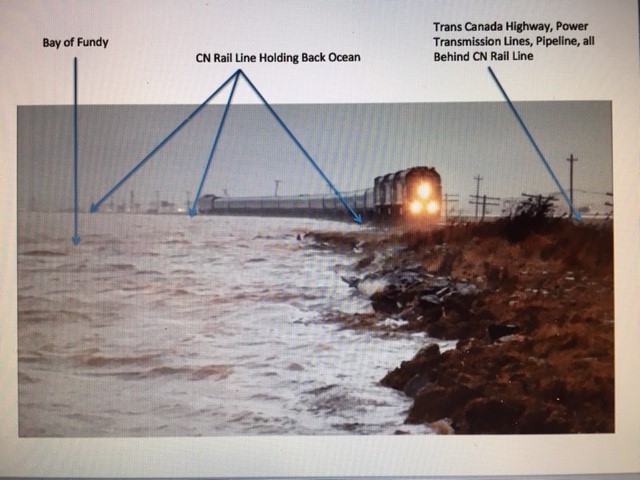
More than six months past its promised release, there’s still no sign of a long-awaited report on the endangered critical transportation corridor that connects New Brunswick and Nova Scotia. There’s been growing concern in recent years that the famous tides of the Bay of Fundy are growing ever higher, presumably as a result of climate change. More and more frequently, storm surges are threatening to overwhelm the Chignecto Isthmus just east of Sackville on the NB side of the provincial boundary. The potential for a flood disaster is top of mind for Cumberland-Colchester MP Stephen Ellis.
“Every day, $50 million dollars worth of trade crosses this essential corridor,” the recently-elected Conservative politician recently wrote to the federal ministers of transport and environment. “It’s one of those things that people take for granted and don’t realize that what happened in British Columbia could easily happen here.”
Dr. Ellis isn’t the first MP to voice concerns about the risk of the Tantramar Marsh being inundated by salt water. Four years ago his predecessor, Liberal Bill Casey, was singing the same tune, describing it as the most vulnerable transportation corridor in all of Canada from an environmental perspective. The CN Rail line across the isthmus is higher than the Trans-Canada Highway, and in effect acts as dyke. If it were ever to be breached, the result could be a catastrophic economic blow to Nova Scotia and to Canada.
The $700,000 engineering study was announced in May of 2018, with the federal government picking up half the cost and the remainder shared by Nova Scotia and New Brunswick. The report was scheduled for release in the spring of 2021, but it remains under wraps. A spokesman for the NB Department of Transportation and Infrastructure confirmed to the Moncton Times and Transcript that the report had indeed been completed, but was still under review by all three governments. Meanwhile, community leaders and MLAs on both sides of the border are growing impatient for answers.
“We’re still waiting for our provincial and federal governments to take climate change and its impacts seriously, but time is running out,” the Green Party’s Tantramar MLA Megan Mitton told reporter Alan Cochrane. And Elizabeth Smith-McCrossin, the independent MLA for Cumberland North, says she’s made flood mitigation one of her priorities for 2022 – even though the most vulnerable point is not in her riding. “We need to stop studying and get the work done,” she said, adding that she’d introduced a bill in the fall session of the NS Legislature that has yet to be debated.
The concerns were echoed by the mayors of both Sackville and Amherst, who are very worried that large areas of their respective communities are under threat of permanent flooding, as ancient 18th-century dykes built by Acadian farmers begin to crumble.
-Ted Bartlett
HALIFAX TRANSIT LAUNCHING NEW INITIATIVES IN 2022
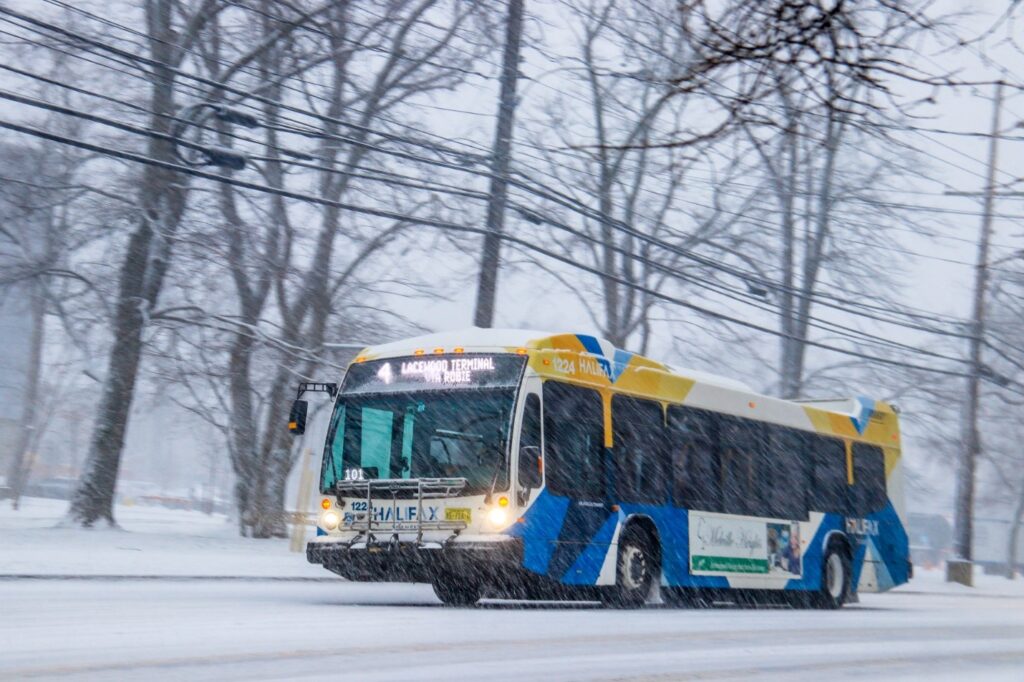
The last couple of years have been rough for transit ridership, but there continues to be work on incremental improvements to the Halifax Transit system. In early December, Halifax regional council approved a year-long pilot project that will see a section of Spring Garden Rd., one of the busiest downtown streets and a major choke point for traffic, converted to bus only access from 7am to 8pm, beginning in June 2022. The section of Spring Garden Rd. in question, between Queen and South Park streets, had been closed for an extended period of time for a comprehensive streetscaping project. With the work now complete, municipal staff proposed that this was an ideal time to launch such a pilot, since car traffic had already been blocked from the street. Council opted instead to wait until June, so as not to have to contend with winter conditions while evaluating the initial success of the pilot. Ultimately, the pilot will be assessed based on pedestrian, customer, and transit rider experience on the street, average transit times, collision data, traffic volumes, and public and area resident feedback.
The transit agency is also set to launch two new initiatives aimed at making the service easier to use for people with disabilities and for newcomers to the city. Planned to launch early in 2022, Halifax Transit is developing an in-person accessibility training program to educate people with disabilities how to use both conventional transit, and the specialized Access-A-Bus service. The program is intended to respond to concerns from people with disabilities that the transit system is intimidating, and will aim to provide more support to help people become comfortable with using transit, covering everything from how to request stops to learning about the audio and visual stop announcement, paying fares, and using the Transit app.
The second program is a training program for newcomers who need help navigating the system, especially those working to overcome language barriers. In addition to providing information about where to buy tickets and how to read transit schedules, the program is expected to bring a bus into communities so newcomers can experience it first hand, with an introduction to the vehicles, explanations of how to use features like bike racks, and an opportunity to talk with staff with the aid of translation services.
-Tim Hayman
LABRADOR’S FIRST-EVER TRANSIT SYSTEM PROPOSED
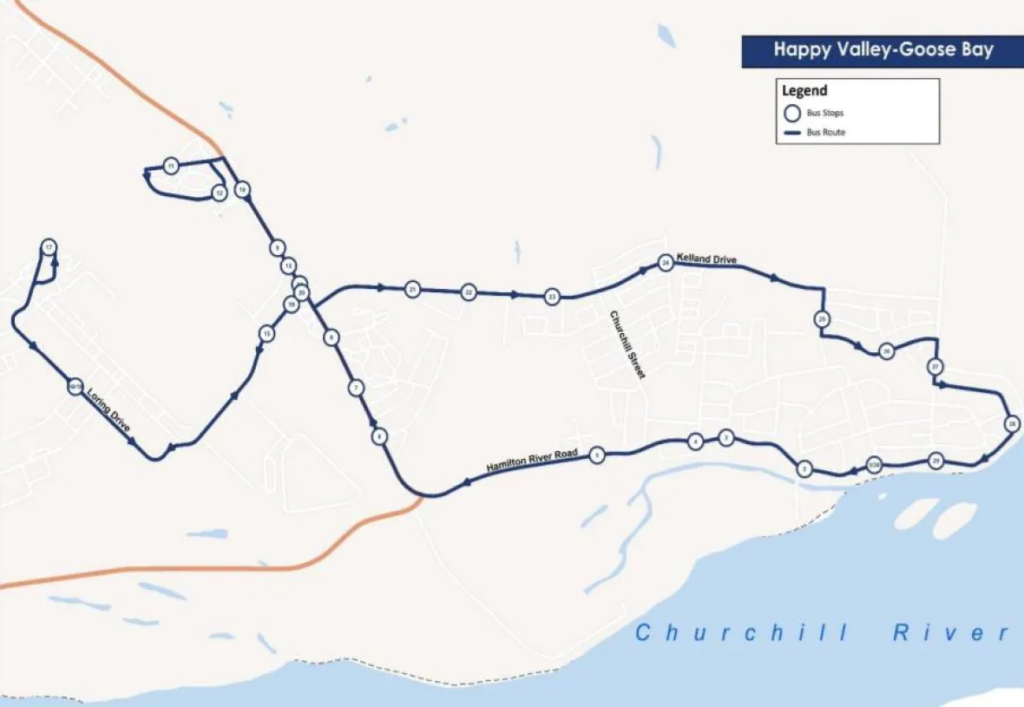
The stage has been set for the first-ever public transit system in Labrador’s largest population centre. A feasibility study conducted at Dalhousie University is recommending a two-route network for Happy Valley-Goose Bay. While there’s no clear answer yet as to how the estimated $180,000 start-up cost for each route and the annual $670,000 annual operating deficit would be funded, there’s growing community enthusiasm for the project.
The study was commissioned by the town council, and released in November. The core route recommended by consultants would be 28 kilometres in length, and would provide an hourly service to the town’s 8100 residents. In addition, service would be provided to North West River and the Sheshatshiu Innu First Nationevery three hours over a longer 92-kilometre route.
Mayor George Andrews told CBC Radio’s Labrador Morning that the proposed system would open up the community to everybody. “Whether it’s a single mom who doesn’t have transportation that needs to go to work, or someone without a vehicle that needs to go to the airport,” he said, adding that Council would be doing due diligence on the file in the near future.
-Ted Bartlett





